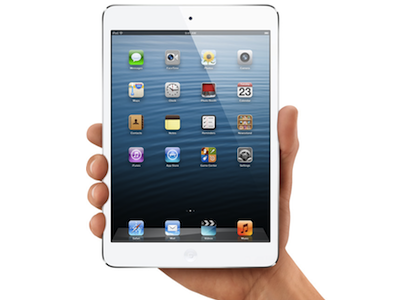Retina Display Already Planned for iPad Mini 2
The iPad mini 2 is expected to arrive in 4Q13 with a Retina display.
Unnamed sources in China report that AU Optronics, which is one of the many suppliers providing 1024 x 768 panels for Apple's slick new iPad mini, plans to enter mass production of 2048 x 1536 resolution 7.9-inch displays (497 ppi) for the iPad mini 2 by the second half of 2013. That seemingly sets the iPad mini's refresh cycle at a full year, following the footsteps of the larger Apple tablets prior to the iPad 4.
MENAFN reports that AUO will cram the Retina screen into a 7.9-inch form factor by adopting Sharp's IGZO (indium gallium zinc oxide) technology to prolong the tablet's battery life without sacrificing brightness. The company will also use Gate IC on array (GOA) which will allow Apple to provide a thinner frame along the perimeter of the screen.
AUO also reportedly said on Wednesday that it had addressed the yield issues currently seen on the first-generation iPad mini that forced the company to limit its supply of displays for Pegatron (which is manufacturing the tablet along with Foxconn), eliminating the problem with bleeding light. AUO plans to ship 800,000 displays in November and 1 million units in December.
On Tuesday UBM TechInsights released its teardown analysis of the current iPad mini, estimating that Apple pays $214.75 for the components in the 16 GB version which has a starting price of $329. The firm also stated that Apple pulls in a gross margin of about 35-percent for the 7.9-inch iOS tablet. By comparison, Apple's component costs for the iPad 4 are reportedly $284, thus Apple is pulling in a 43-percent gross margin.
Recently critics have been pointing out the iPad mini's 1024 x 768 display as one of the tablet's major setbacks, saying it's "very capable" but doesn't follow Apple's high-quality display tradition. At 163 pixels per inch, it also doesn't stand up to the 216-ppi displays found on Google's Nexus 7 or Amazons's Kindle Fire HD. Even more, it's believed that Apple could have at least cranked up the resolution to 1280 x 960 and provide older apps in a letterboxed format.
Contact Us for News Tips, Corrections and Feedback
Get Tom's Hardware's best news and in-depth reviews, straight to your inbox.

Kevin Parrish has over a decade of experience as a writer, editor, and product tester. His work focused on computer hardware, networking equipment, smartphones, tablets, gaming consoles, and other internet-connected devices. His work has appeared in Tom's Hardware, Tom's Guide, Maximum PC, Digital Trends, Android Authority, How-To Geek, Lifewire, and others.
-
kawininjazx The whole point of the iPad Mini NOT having a retina display is so they could release another one WITH a retina display. It's normal Apple BS.Reply -
azathoth Congratulations sheep, your new device is already obsolete.Reply
They were perfectly capable of doing the first iPad mini with a retina display, but then sheep wouldn't feel a need to purchase the next "revolutionary device" by Apple. -
guess who This fails the reasonableness test.Reply
http://www.theregister.co.uk/2012/11/07/apple_screen_maker_eying_retina_ipad_mini_pants_site/ -
robochump Lol...iHaters always first to respond to Apple articles like true haters...woot woot. Anyways Apple should have released iPad mini with retina though to make strong push for next iPad mini you need a solid upgrade so retina it is. All companies release products by keeping in mind about how to sell future versions of the product.Reply -
rosen380 fAndroid: "Congratulations sheep, your new device is already obsolete."Reply
Tom's: "The iPad mini 2 is expected to arrive in 4Q13 with a Retina display."
So, a year from now, Apple expects to refresh it's new product. Prior to the new new iPad, wasn't that the status quo...? -
saltorio And what is the purpose of 497 ppi? Sure it gives some level of "ours is bigger" claim, but people have enough of an issue seeing pixels at 300 ppi. So you end up with an ultra-dense screen, where all the icons and graphics have to be scaled to ridiculous degrees just to be functional parts of the UI.Reply -
baconeater kawininjazxThe whole point of the iPad Mini NOT having a retina display is so they could release another one WITH a retina display. It's normal Apple BS.Reply
Ok so this PURELY apple that does this correct?
wozza365and by then the nexus 7 2 will probably have a 1920x1200 or 2560x1600 screen
And you're saying that GOOGLE ALSO incrementally increases their resolution on their tablets?
So by that logic GOOGLE AND APPLE(and other companies) both introduce a product then release a successor that has BETTER specs? But, it's only Apple that does this "BS" correct?
-
sacre This is why I said "No more" to Apple. They release a product which should have had their already old technology, but decide to "wait" and add that to the successor. Then tell everyone this a week after they release the first ipad mini. All about money with this company, who gives a shit about the customer, right?Reply
Up your Apple. Really. Just up yours. -
tramit "All about money with this company, who gives a shit about the customer, right?"Reply
All companies are about the money. Period.
